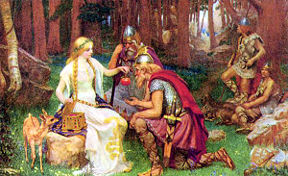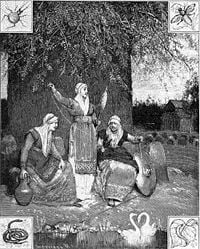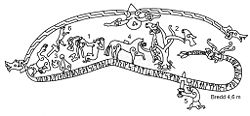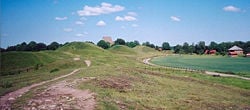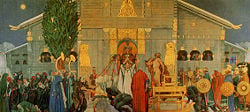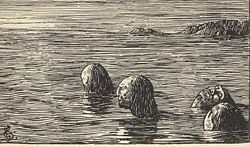Difference between revisions of "Norse Mythology" - New World Encyclopedia
Chris Jensen (talk | contribs) |
Chris Jensen (talk | contribs) |
||
| Line 5: | Line 5: | ||
|- | |- | ||
| | | | ||
| − | |||
| − | |||
| − | |||
| − | |||
| − | |||
| − | |||
| − | |||
| − | |||
| − | |||
| − | |||
| − | |||
| − | |||
| − | |||
| − | |||
| − | |||
| − | |||
| − | |||
| − | |||
| − | |||
| − | |||
| − | |||
| − | |||
| − | |||
| − | |||
| − | |||
| − | |||
| − | |||
| − | |||
| − | |||
| − | |||
| − | |||
| − | |||
| − | |||
| − | |||
| − | |||
| − | |||
| − | |||
| − | |||
| − | |||
| − | |||
| − | |||
| − | |||
|} | |} | ||
| Line 163: | Line 121: | ||
| Sunday || Sun's day | | Sunday || Sun's day | ||
|} | |} | ||
| − | The Germanic | + | The gods of Norse and Germanic mythology have left numerous traces in elements of everyday life in most Western countries (especially those who use a Germanic language). An example of this is some of the names of the days of the week, which were modelled after the names of the days of the week in [[Latin]] (named after ''Sun, Moon, Mars, Mercury, Jupiter, Venus, Saturn''), where the names for Tuesday through to Friday were replaced with the names of divine Germanic equivalents. In English, Saturn was not replaced, while Saturday is named after the [[sabbath]] in German, and is called "washing day" in Scandinavia. |
===Germanic neopaganism=== | ===Germanic neopaganism=== | ||
{{main|Germanic neopaganism}} | {{main|Germanic neopaganism}} | ||
| − | + | ||
| + | The nineteenth and twentieth centuries have seen attempts to revive the old Germanic religion in both [[Europe]] and the [[United States]] under various names, including ''Ásatrú'' ("Aesir Faith"), Odinism, Wotanism, ''Forn Sed'' ("Old Custom") or [[Heathenry]]. In Iceland, Ásatrú was recognized by the state as an official religion in 1973, which legalized its various ceremonies (e.g. marriage and child-naming). It has also become an official and legal religion in all the Nordic countries, though it is still a fairly new development (at least in this modern iteration). | ||
===Modern popular culture=== | ===Modern popular culture=== | ||
| − | + | The Romanticism that popularized Norse mythology among American and European intellectuals also impacted popular culture. For instance, [[Richard Wagner]]'s ''Ring Cycle'' (''[[Der Ring des Nibelungen]]'' is heavily based upon Norse mythology, including tales of [[Odin]], [[Frigga]], [[Loki]], the [[Valkyries]], and [[Ragnarok]]. | |
| − | + | ||
| + | Subsequently, [[J. R. R. Tolkien|J.R.R. Tolkien's]] ''The Lord of the Rings'' was also heavily influenced by the indigenous beliefs of the pre-Christian Northern Europeans. As that work became popular, elements of its fantasy world moved steadily into popular perceptions of the fantasy genre. In fact, nearly any modern fantasy novel contains such Norse creatures as elves, dwarves, and frost giants. In this way, Norse mythology has been single-handedly (though indirectly) responsible for the development of an entire literary genre. | ||
| + | |||
| + | Finally, Norse figures and concepts are frequently found in such diverse media as comic books (most notably Marvel Comics "Thor" and DC Vertigo's "Sandman"), Japanese animation (including "Aa! Megami-sama") and video games (such as Tales of Symphonia, Valkyrie Profile and Max Payne). | ||
| + | |||
| + | See [http://en.wikipedia.org/w/index.php?title=Norse_mythology_in_popular_culture&oldid=107374828 Wikipedia] for a more complete listing. | ||
| − | |||
| − | |||
| − | |||
| − | |||
| − | |||
| − | |||
==External links== | ==External links== | ||
Revision as of 20:48, 13 February 2007
Norse or Scandinavian mythology comprises the pre-Christian legends and religious beliefs of the Scandinavian people. Norse mythology is the best-preserved version of the older common Germanic mythology, which also includes the closely related Anglo-Saxon mythology.
Norse mythology is a collection of beliefs and stories shared by Northern Germanic tribes, which tend to reflect their cultural focus on physical prowess and military might. Since this mythological tradition was orally transmitted in the form of odes, sagas, and poetic epics, our knowledge about it is primarily based on the Eddas and other medieval texts written down during and after the conversion and Christianization of these regions. The vast majority of written sources comprising this modern understanding were assembled from accounts recorded in Iceland in the eleventh century CE.
In Scandinavian folklore, these beliefs have long held cultural currency, to the extent that some traditions based upon them have been maintained until the present day. Others have recently been reinvented under the rubric of Germanic Neopaganism. Also, this rich mythological tradition also remains as an inspiration in literature, as well as for other forms of artwork (including visual representations, films, comic books and stage productions).
Sources
Given that Norse mythological and religious traditions were transmitted orally, few have survived into the modern day - due, at least in part, to the persecution of these beliefs under Christian rule. However, some of these tales were captured and recorded by Christian scholars, particularly in the Eddas and the Heimskringla by Snorri Sturluson (1178-1241 C.E.), who believed that pre-Christian deities were men and women rather than devils (and would thus reveal elements of their respective culture's histories). Sturluson, who was a leading poet, chieftain, and diplomat in Iceland, condensed the extensive sagas into prose retellings that made the various tales of Norse mythology systematic and coherent. An additional source for the modern understanding of this tradition is the Poetic Edda (also known as the Elder Edda), which contains poetic versions of tales found in the Prose Edda. More specifically, it consists of 29 long poems, of which 11 deal with the Germanic deities, the rest with legendary heroes like Sigurd the Volsung (the Siegfried of the German version, Nibelungenlied). Although scholars think it was transcribed later than the other Edda, the language and poetic forms involved in the tales appear to have been composed centuries earlier than their transcription. Over and above the Eddas, there is also the Danish Gesta Danorum by Saxo Grammaticus, which is unfortunately of lesser utility due to the author's more extensive editorial alterations.
Besides these sources, there are surviving legends in Scandinavian folklore. Some of these can be corroborated with legends appearing in other Germanic literatures (e.g. the tale related in the Anglo-Saxon Battle of Finnsburgh) and the many allusions to mythological tales in the Old English poem Deor. When several partial references and tellings survive, scholars can often deduce the underlying tale.
Finally, the archaeological record can also be seen to provide useful clues concerning the nature of these beliefs. For instance, scholars have discovered and translated some runic inscriptions, such as the Rök Runestone and the Kvinneby amulet, that make reference to Nordic mythology. Likewise, there are also numerous runestones and image stones that depict scenes from Norse mythology, such as Thor's fishing trip, scenes from the Völsunga saga, Odin and Sleipnir, Loki with curled dandy-like mustaches and lips that are sewn together, Odin being devoured by Fenrir, and Hyrrokkin riding to Balder's funeral (the last of these is depicted on one of the surviving stones from the Hunnestad Monument).
Cosmology
Scandinavians believed that the cosmos was divided into nine interrelated realms, some of which attracted considerably greater mythological attention. Of primary importance was the threefold separation of the universe into the realms of the gods (Asgard and Vanaheim, homes of the Aesir and Vanir, respectively), the realm of mortals (Midgard) and the frigid underworld (Niflheim), home of the frost giants. These three realms were supported by an enormous tree (Yggdrasil), with the realm of the gods ensconced among the upper branches, the realm of mortals approximately halfway up the tree (and surrounded by an impassable sea), and the underworld nestled among its roots.
Asgard could be reached by traversing Bifrost, a magical rainbow bridge guarded by Heimdall, the mute god of vigilance who could see and hear a thousand miles. Valhalla, Odin's hall (which is located within Asgard), can be seen as the Norse Heaven, as it is the final resting place for the souls of the greatest human warriors. To earn one's place among them, it was required that one's bravery be observed by the Valkyries, Odin's mounted female messengers whose sparkling armor supposedly created the famed Aurora Borealis (northern lights).
Other less important realms include Muspell, world of burning heat and home of Surt, a giant whose skin was lava and who had hair of fire; Alfheim, world of the elves; Svartálfheim, home of the dark elves; Nidavellir, world of the dwarves, tiny men who were incomparable miners and goldsmiths; and Jotunheim, world of the Jotun or giants.
The cosmology of Norse mythology also involves certain elements of duality. For example, the night and the day have their own mythological counterparts - Dagr/Skinfaxi and Nótt/Hrímfaxi, the sun (Sol) and the chasing wolf (Skoll), the moon (Mani) and its chasing wolf (Hati), and the total opposites of Niflheim and Muspell in the origin of the world and its cosmic composition. This might have reflected a deeper metaphysical belief in a fundamentally oppositional world.
Supernatural beings
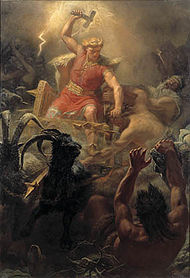
Norse cosmology postulates three separate "clans" of deities: the Aesir, the Vanir, and the Jotun. The distinction between Aesir and Vanir is relative, for the two are said to have made peace, exchanged hostages, intermarried and reigned together after a prolonged war, which the Aesir had finally won. In fact, the most major divergence between the two groups is in their respective areas of influence, with the Aesir representing war and conquest, and the Vanir representing exploration, fertility and wealth.[1] Some of the most important of these deities include Odin, the father god who rules the pantheon; Frigg, Odin's wife and queen of the gods; Thor, a storm god and warrior/hero; Freya, the goddess of beauty and sexual attraction; Heimdall, the far-seeing sentry of Asgard; Tyr, the god of combat; Balder, the god of spring and renewal; and, Loki, the devious trickster deity.
The relative peace between the Aesir and the Vanir presents a profound contrast to their permanently stormy relations with the the Jotun (Old English: Eotenas or Entas). This group, whose name is often translated as "giants" (although "trolls" and "demons" have been suggested as suitable alternatives), are generally depicted as foul, monstrous beings, comparable to the Titans and Gigantes of Greek mythology. Despite these negative associations, the gods were still seen to be relatively closely related to the Jotun, as both Æsir and Vanir continued to intermarry with the Giants (not to mention the fact that many of the gods were descendants of them). For example, Loki was the child of two giants, and Hel was half-giantess. Some of the giants are mentioned by name in the Eddas and they seem to be representations of natural forces.
In addition, there are many other supernatural beings, including elves, dwarves, and monsters (including Fenrir, the gigantic wolf, and Jörmungandr, the sea-serpent (or "worm") that is coiled around Midgard). These two creatures are described as the progeny of Loki, the trickster-god, and a giantess.
Along with many other polytheistic religions, this mythology lacks the predomninant good-evil dualism of the monotheistic Middle Eastern traditions. Thus, Odin and Hel are not seen as pure opposites, Loki is not primarily an adversary of the gods, though he is seen to delight in causing Thor's plans to go awry. Likewise, the giants are not so much fundamentally evil, as they are rude, boisterous, and uncivilized. Thus, the dualism that exists is not an opposition of good versus evil, but order versus chaos.
Völuspá: the origin and end of the world
The origin and eventual fate of the world are described in Völuspá ("The völva's prophecy" or "The sybil's prophecy"), one of the most striking poems in the Poetic Edda. These haunting verses contain one of the most vivid creation accounts in all of religious history and a representation of the eventual destruction of the world that is unique in its combination of the themes of apocalypse and rebirth.
In the Völuspá, Odin, the chief god of the Norse pantheon, has conjured up the spirit of a dead Völva (shaman or sybil) and commanded this spirit to reveal the past and the future. She is reluctant, and asks: "What do you ask of me? Why tempt me?" but since she is already dead, she shows no fear of Odin. In fact, as she begins to detail the collapse of the universe, she continually taunts him: "Well, would you know more?" Despite his evident despair, Odin insists, reasoning that if he is to fulfill his function as king of the gods, he must possess all knowledge. The poem ends when the sybil finishes revealing the secrets of creation and dissolution, at which point she returns to the underworld, leaving Odin to contemplate the traumatic future that he and the other Aesir will eventually face.
The beginning
According to the Scandinavians, the universe in its primordial state was a realm of fire (Muspell) and ice (Niflheim). When the warm air of Muspell hit the cold ice of Niflheim, the outline of a giant (Ymir) and the icy cow (Audhumla) were created. Slowly, the giant cow began to lick the frost off of the sleeping giant's skin, eventually freeing him from his icy prison. As Ymir slept, the continuing heat from Muspell made him sweat. He sweat out Surt, a flaming giant who went to Muspell, whose fire made him feel welcome. Later, Ymir woke and drank Audhumla's milk. But each drop of milk he spilled became a god: Odin, Vili and Ve, who proceeded to create seven more worlds and their inhabitants.
The sybil then describes Yggdrasil (the world tree that supports the realms of gods, giants and humans) and the three norns (female symbols of inexorable fate, whose names indicate the past, present, and future), who spin the threads of fate amid the tree's enormous roots. Next, she describes the additional past events, including the primeval war between Æsir and Vanir. and the murder of Baldr, Odin's handsome son. Completing this chronicle, she then turns her attention to the future.
End times (Eschatological beliefs)
The Old Norse vision of the future is bleak. Norse mythology's vision of the end times is uniquely stark and pessimistic: not only are the Norse gods capable of being defeated by residents of Yggdrasil's other branches, but they are in fact destined to be defeated, and have always lived with this knowledge. In the end, it was believed, the forces of chaos will outnumber and overcome the divine and human guardians of order. Loki and his monstrous children will burst their bonds; the dead will sail from Niflheim to attack the living. Heimdall, the watchman of the gods, will summon the heavenly host with a blast on his horn, which will precipitate the final doomed battle between order and chaos (Ragnarök). The gods, aware of the futility of their plight, will nevertheless gather the finest warriors (the Einherjar) from Valhalla to fight on their side when the day comes, but in the end they will be powerless to prevent the world from descending into the chaos out of which it had once emerged; the gods and their world will be destroyed.
However, some traditions include an optimistic conclusion. Not only will chaos also be defeated, but a new, better world will emerge from the ashes of the old one. Odin will be swallowed by Fenrir. Thor will kill Jörmungandr, but will drown in its venom. Loki, the quintessentially liminal figure (embodying both the chaos of the giants and the order of the gods) will be the last to die, after having taken a wound from Heimdall. In some accounts, the death of the Aesir frees the world and allows for the rebirth of Balder, who returns to usher in an era of peace and plenitude.
Kings and heroes
The Norse mythological literature, in addition to its concentration on supernatural creatures and divine realms, also relates many legends concerning human heroes and kings. These tales, often told about the founders of clans and kingdoms, possessed great importance as illustrations of national origins and as models of proper action. The heroic literature may have fulfilled the same function as the national epic in other European literatures or it may have been more closely related to tribal identity. Many of the legendary figures probably existed, leading generations of Scandinavian scholars to attempt to extract history from myth in the sagas.
Sometimes, the same hero resurfaces in several forms depending on which part of the Germanic world the epics survived such as Weyland/Völund and Siegfried/Sigurd, and probably Beowulf/Bödvar Bjarki. Other notable heroes are Hagbard, Starkad, Ragnar Lodbrok, Sigurd Ring, Ivar Vidfamne and Harald Hildetand. Notable also are the shieldmaidens, who were "ordinary" women who had chosen the path of the warrior. These women function both as heroines and as obstacles to the heroic journey.
Norse worship
Centers of faith
The Germanic tribes rarely ever had temples in a modern sense, as the Blót, the form of worship practiced by the ancient Germanic and Scandinavian people, was often celebrated outdoors, in sacred groves. This worship could also take place at home and at simple altars of piled stones known as horgr.
However, the Scandinavian world did have a few important ritual centers, such as Skiringsal, Lejre and Uppsala, where more formalized worship was carried out. For example, Adam of Bremen, an important chronicler of the Christianization of Scandinavia, claims that there was a relatively impressive temple in Uppsala with three wooden statues of Thor, Odin and Freyr.
Priests
While religious professionals seem to have existed in Norse culture, they never took on the professional and semi-hereditary character of the Celtic druidical class. This was because the shamanistic aspect of the tradition was maintained by women, the Völvas, meaning that the male ritual specialists played a more restricted role than their druidic counterparts.
It is often said that the Germanic tradition of kingship evolved out of a priestly office, as the priestly role of the king was congruent with the general role of godi, who was the head of a kindred group of families and who administered the sacrifices.
Human sacrifice
A unique eye-witness account of Germanic human sacrifice survives in Ibn Fadlan's account of a Rus ship burial, where a slave-girl had volunteered to accompany her lord to the next world. More indirect accounts are given by Tacitus, Saxo Grammaticus and Adam von Bremen.
However, the Ibn Fadlan account is actually a burial ritual. Current understanding of Norse mythology suggests an ulterior motive to the slave-girl's 'sacrifice'. It is believed that in Norse mythology a woman who joined the corpse of a man on the funeral pyre would be that man's wife in the next world. For a slave girl to become the wife of a lord was an obvious increase in status. Although both religions are of the Indo-European tradition, the sacrifice described in the Ibn Fadlan account is not to be confused with the oft-contested Hindu practice of Sati.
The Heimskringla tells of Swedish King Aun who sacrificed nine of his sons in an effort to prolong his life until his subjects stopped him from killing his last son (Egil). According to Adam of Bremen, the Swedish kings sacrificed male slaves every ninth year during the Yule sacrifices at the Temple at Uppsala. The Swedes had the right not only to elect kings but also to depose them, and both king Domalde and king Olof Trätälja are said to have been sacrificed after years of famine.
Finally, as Odin was associated with death by hanging, a possible practice of Odinic sacrifice by strangling has some archeological support in the existence of bodies perfectly preserved by the acid of the Jutland (later taken over by Danish people) peat bogs, into which they were cast after having been strangled. An example is Tollund Man. However, as we possess no written accounts that explicitly interpret the cause of these stranglings, they could obviously have other explanations.
Interactions with Christianity
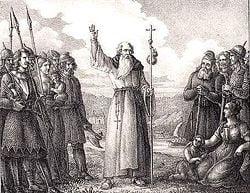
An important problem in interpreting this mythology is that often the closest accounts that we have to "pre-contact" times were written by Christians. The Younger Edda and the Heimskringla were written by Snorri Sturluson in the 13th century, over two hundred years after Iceland became Christianized. This results in Snorri's works carrying a large amount of Euhemerism.
Virtually all of the saga literature came out of Iceland, a relatively small and remote island, and even in the climate of religious tolerance there, Snorri was guided by an essentially Christian viewpoint. The Heimskringla provides some interesting insights into this issue. Snorri introduces Odin as a mortal warlord in Asia who acquires magical powers, settles in Sweden, and becomes a demi-god following his death. Having undercut Odin's divinity, Snorri then provides the story of a pact of Swedish King Aun with Odin to prolong his life by sacrificing his sons. Later in the Heimskringla, Snorri records in detail how converts to Christianity such as Saint Olaf Haraldsson brutally converted Scandinavians to Christianity.
Trying to avert civil war, the Icelandic parliament voted in Christianity, but for some years tolerated heathenry in the privacy of one's home. Sweden, on the other hand, had a series of civil wars in the 11th century, which ended with the burning of the Temple at Uppsala. In England, on the other hand, Christianization occurred earlier and sporadically, rarely by force. Conversion by coercion was sporadic throughout the areas where Norse gods had been worshipped. However, the conversion did not happen overnight. Christian clergy did their utmost to teach the populace that the Norse gods were demons, but their success was limited and the gods never became evil in the popular mind in most of Scandinavia.
Two centrally located and far from isolated settlements can illustrate how long the Christianization took. Archaeological studies of graves at the Swedish island of Lovön have shown that the Christianisation took 150-200 years, and this was a location close to the kings and bishops. Likewise in the bustling trading town of Bergen, many runic inscriptions have been found from the 13th century, among the Bryggen inscriptions. One of them says may Thor receive you, may Odin own you, and a second one is a galdra which says I carve curing runes, I carve salvaging runes, once against the elves, twice against the trolls, thrice against the thurs. The second one also mentions the dangerous Valkyrie Skögul.
Otherwise there are few accounts from the 14th to the 18th century, but the clergy, such as Olaus Magnus (1555) wrote about the difficulties of extinguishing the old beliefs. The story related in Þrymskviða appears to have been unusually resilient, like the romantic story of Hagbard and Signy, and versions of both were recorded in the 17th century and as late as the 19th century. In the 19th and early 20th century Swedish folklorists documented what commoners believed, and what surfaced were many surviving traditions of the gods of Norse mythology. However, the traditions were by then far from the cohesive system of Snorri's accounts. Most gods had been forgotten and only the hunting Odin and the giant-slaying Thor figure in numerous legends. Freyja is mentioned a few times and Baldr only survives in legends about place names.
Other elements of Norse mythology survived without being perceived as such, especially concerning supernatural beings in Scandinavian folklore. Moreover, the Norse belief in destiny has been very firm until modern times. Since the Christian hell resembled the abode of the dead in Norse mythology one of the names was borrowed from the old faith, Helvíti i.e. Hel's punishment. Some elements of the Yule traditions were preserved, such as the Swedish tradition of slaughtering the pig at Christmas (Christmas ham), which originally was part of the sacrifice to Freyr.
Modern influences
| Day | Origin |
|---|---|
| Monday | Moon's day |
| Tuesday | Tyr's (Tiw's) day |
| Wednesday | Odin's (Wodin's) day |
| Thursday | Thor's day |
| Friday | Frigg's or Freyja's day |
| Sunday | Sun's day |
The gods of Norse and Germanic mythology have left numerous traces in elements of everyday life in most Western countries (especially those who use a Germanic language). An example of this is some of the names of the days of the week, which were modelled after the names of the days of the week in Latin (named after Sun, Moon, Mars, Mercury, Jupiter, Venus, Saturn), where the names for Tuesday through to Friday were replaced with the names of divine Germanic equivalents. In English, Saturn was not replaced, while Saturday is named after the sabbath in German, and is called "washing day" in Scandinavia.
Germanic neopaganism
The nineteenth and twentieth centuries have seen attempts to revive the old Germanic religion in both Europe and the United States under various names, including Ásatrú ("Aesir Faith"), Odinism, Wotanism, Forn Sed ("Old Custom") or Heathenry. In Iceland, Ásatrú was recognized by the state as an official religion in 1973, which legalized its various ceremonies (e.g. marriage and child-naming). It has also become an official and legal religion in all the Nordic countries, though it is still a fairly new development (at least in this modern iteration).
Modern popular culture
The Romanticism that popularized Norse mythology among American and European intellectuals also impacted popular culture. For instance, Richard Wagner's Ring Cycle (Der Ring des Nibelungen is heavily based upon Norse mythology, including tales of Odin, Frigga, Loki, the Valkyries, and Ragnarok.
Subsequently, J.R.R. Tolkien's The Lord of the Rings was also heavily influenced by the indigenous beliefs of the pre-Christian Northern Europeans. As that work became popular, elements of its fantasy world moved steadily into popular perceptions of the fantasy genre. In fact, nearly any modern fantasy novel contains such Norse creatures as elves, dwarves, and frost giants. In this way, Norse mythology has been single-handedly (though indirectly) responsible for the development of an entire literary genre.
Finally, Norse figures and concepts are frequently found in such diverse media as comic books (most notably Marvel Comics "Thor" and DC Vertigo's "Sandman"), Japanese animation (including "Aa! Megami-sama") and video games (such as Tales of Symphonia, Valkyrie Profile and Max Payne).
See Wikipedia for a more complete listing.
External links
- Viktor Rydberg's "Teutonic Mythology: Gods and Goddesses of the Northland" e-book
- W. Wagner's "Asgard and the Home of the Gods" e-book
- H. A. Guerber's "Myths of Northern Lands" e-book
- Peter Andreas Munch's "Norse Mythology: Legends of Gods and Heroes" e-book
- A collection of most of the standard texts in English translation
- heimskringla.no Old Norse Prose and Poetry
- Nordische Götter - Götter-Portal (German)
- Sacred-Texts.com - More source materials
- Timeless Myths - Norse Mythology - Information and tales from Norse and Germanic literatures
- Jörmungrund: Skálda- & vísnatal Norrœns Miðaldkveðskapar [Index of Old Norse/Icelandic Skaldic Poetry] (in Icelandic)
- Project Runeberg - a Nordic equivalent to Project Gutenberg
- Norse Gods, Goddesses, Giants, Dwarves and Wights
- CyberSamurai Encyclopedia of Norse Mythology
- [1]
- Squid vs. Thor: Teuthid Imagery in Norse Mythology
Bibliography
- Primary Sources
- The Prose Edda
- The Poetic Edda
- Gesta Danorum
- Ynglingasaga
- Modern retellings (often inventive)
- Armstrong, Fredrick and Puls, Dave (2004). It Came From Animatus. Rochester, N.Y.: Animatus Studio. DVD UPC: 825346-49479-1. Includes The Derf The Viking Trilogy, a cartoon series featuring the Norse gods.
- Colum, Padraic (1920). The Children of Odin: A Book of Northern Myths, illustrated by Willy Pogány. New York, Macmillan. Reprinted 2004 by Aladdin, ISBN 0-689-86885-5.
- Sacred Texts: The Children of Odin. (Illustrated.)
- Crossley-Holland, Kevin (1981). The Norse Myths. New York: Pantheon Books. ISBN 0-394-74846-8. Also released as The Penguin Book of Norse Myths: Gods of the Vikings. Harmondsworth: Penguin. ISBN 0-14-025869-8.
- d'Aulaire, Ingri and Edgar (1967). "d'Aulaire's Book of Norse Myths". New York, New York Review of Books.
- Guerber, H. A. (1909). Myths of the Norsemen: From the Eddas and Sagas. London: George G. Harrap. Reprinted 1992, Mineola, N.Y.: Dover. ISBN 0-486-27348-2. (The scholarly veneer is deceptive. Material from primary sources, scholarly speculation, and secondary invention is indistinguishably mixed.)
- Keary, A & E (1909), The Heroes of Asgard. New York: Macmillan Company. Reprinted 1982 by Smithmark Pub. ISBN 0-8317-4475-8. Reprinted 1979 by Pan Macmillan ISBN 0-333-07802-0.
- Mable, Hanilton Wright (1901). Norse Stories Retold from the Eddas. Mead and Company. Reprinted 1999, New York: Hippocrene Books. ISBN 0-7818-0770-0.
- Mackenzie, Donald A. (1912). Teutonic Myth and Legend. New York: W. H. Wise & Co. 1934. Reprinted 2003 by University Press of the Pacific. ISBN 1-4102-0740-4.
- Munch, Peter Andreas (1927). Norse Mythology: Legends of Gods and Heroes, Scandinavian Classics. Trans. Sigurd Bernhard Hustvedt (1963). New York: American-Scandinavian Foundation. ISBN 0-404-04538-3.
- Rydberg, Viktor (1889). Teutonic Mythology, trans. Rasmus B. Anderson. London: Swan Sonnenschein & Co. Reprinted 2001, Elibron Classics. ISBN 1-4021-9391-2. Reprinted 2004, Kessinger Publishing Company. ISBN 0-7661-8891-4. (Rydberg's theories, although interesting, are generally not accepted.)
- Rydberg's Teutonic Mythology (Displayed by pages.)
- General secondary works
- Branston, Brian (1980). Gods of the North. London: Thames and Hudson. (Revised from an earlier hardback edition of 1955). ISBN 0-500-27177-1.
- Davidson, H. R. Ellis (1964). Gods and Myths of Northern Europe. Baltimore: Penguin. New edition 1990 by Penguin Books. ISBN 0-14-013627-4. (Several rune stones)
- —————— (1969). Scandinavian Mythology. London and New York: Hamlyn. ISBN 0-87226-041-0. Reissued 1996 as Viking and Norse Mythology. New York: Barnes and Noble.
- de Vries, Jan. Altgermanische Religionsgeschichte, 2 vols., 2nd. ed., Grundriss der germanischen Philogie, 12–13. Berlin: W. de Gruyter. (Generally considered the most authoritative current standard reference.)
- Dumézil, Georges (1973). Gods of the Ancient Northmen. Ed. & trans. Einar Haugen. Berkeley: University of California Press. ISBN 0-520-03507-0.
- Grimm, Jacob (1888). Teutonic Mythology, 4 vols. Trans. S. Stallybras. London. Reprinted 2003 by Kessinger. ISBN 0-7661-7742-4, ISBN 0-7661-7743-2, ISBN 0-7661-7744-0, ISBN 0-7661-7745-9. Reprinted 2004 Dover Publications. ISBN 0-486-43615-2 (4 vols.), ISBN 0-486-43546-6, ISBN 0-486-43547-4, ISBN 0-486-43548-2, ISBN 0-486-43549-0.
- Lindow, John (1988). Scandinavian Mythology: An Annotated Bibliography, Garland Folklore Bibliographies, 13. New York: Garland. ISBN 0-8240-9173-6.
- —————— (2001). Norse Mythology: A Guide to the Gods, Heroes, Rituals, and Beliefs. Oxford: Oxford University Press. ISBN 0-19-515382-0. (A dictionary of Norse mythology.)
- Mirachandra (2006). Treasure of Norse Mythology Volume I ISBN 978-3-922800-99-6.
- Orchard, Andy (1997). Cassell's Dictionary of Norse Myth and Legend. London: Cassell. ISBN 0-304-36385-5.
- Page, R. I. (1990). Norse Myths (The Legendary Past). London: British Museum; and Austin: University of Texas Press. ISBN 0-292-75546-5.
- Simek, Rudolf (1993). Dictionary of Northern Mythology. Trans. Angela Hall. Cambridge: D. S. Brewer. ISBN 0-85991-369-4. New edition 2000, ISBN 0-85991-513-1.
- Simrock, Karl Joseph (1853–1855) Handbuch der deutschen Mythologie.
- Turville-Petre, E. O. Gabriel. (1964). Myth and Religion of the North: The Religion of Ancient Scandinavia. London: Weidenfeld & Nicolson. Reprinted 1975, Westport, Conn.: Greenwood Press. ISBN 0-8371-7420-1.
Credits
New World Encyclopedia writers and editors rewrote and completed the Wikipedia article in accordance with New World Encyclopedia standards. This article abides by terms of the Creative Commons CC-by-sa 3.0 License (CC-by-sa), which may be used and disseminated with proper attribution. Credit is due under the terms of this license that can reference both the New World Encyclopedia contributors and the selfless volunteer contributors of the Wikimedia Foundation. To cite this article click here for a list of acceptable citing formats.The history of earlier contributions by wikipedians is accessible to researchers here:
The history of this article since it was imported to New World Encyclopedia:
Note: Some restrictions may apply to use of individual images which are separately licensed.
- ↑ Some scholars have speculated that this tale symbolized the way the gods of invading Indo-European tribes supplanted older nature-deities of the aboriginal peoples, although it should be firmly noted that this is conjecture. Other authorities (compare Mircea Eliade and J.P. Mallory) consider the Æsir/Vanir division to be simply the Norse expression of a general Indo-European division of divinities, parallel to that of Olympians and Titans in Greek mythology, and in parts of the Mahabharata.
